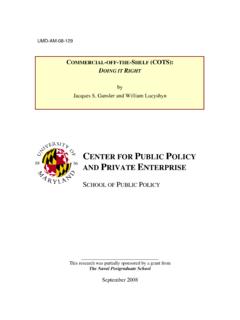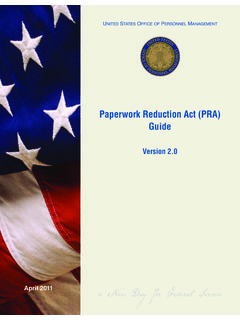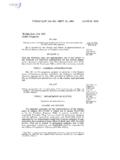Transcription of Enterprise Architecture Governance Procedures
1 INFORMATION DIRECTIVE PROCEDUREE nterprise Architecture Governance Procedures Directive No.: CIO CIO Approval: 12/21/2017 Transmittal No.: 12-007* Page 1 of 24 Form Rev. 3/2/2017 Issued by the EPA Chief Information Officer, Pursuant to Delegation 1-19, dated 07/07/2005 Enterprise Architecture Governance Procedures purpose of the EPA Enterprise Architecture1 Governance Procedures ( EAProcedures ) is to describe the Architecture business processes that support the EPAEA Policy and lay out a structured methodology for identifying, collecting, andmaintaining architectural information across the Agency. The EA Procedures aim toensure that EA activities are performed in a consistent, structured, and reusablemanner. This document specifies high-level Architecture development and approvalprocesses, and also links to the Federal Segment Architecture Methodology (FSAM),which provides best practices for Architecture EA Procedures distinguish between the roles of the National Program Offices andOEI s EA Team in leading Architecture activities.
2 As the Program Offices maintainarchitectures for the business functions under their purview, the EA Team collects,validates, and integrates those architectures into EPA s overarching EnterpriseArchitecture. The complementary relationship between the EA Team and ProgramOffices should improve overall IT investment decision making, reduce redundancyamong investments, and support improved program EA Procedures : outline the recommended Architecture phases for the definition,acquisition, development, implementation, operations and maintenance, and terminationof EPA information technology (IT) systems and applications; apply to all EPA IT systemsand projects, both applications and general support systems (GSS); are applicable tocustom-developed, commercial-off-the-shelf (COTS), and government-off-the-shelf(GOTS) projects; and apply to all systems and contractor developed IT systems, whetherhosted at the EPA National Computer Center (NCC) or another audience for the EA Policy includes individuals who manage, plan, or oversee EPA sbusiness, data, applications, technology, and IT investments, as specified in the EPA EAPolicy, Section The Enterprise Architecture is a strategic information asset base that describes the Agency s business, the information necessary to operate the business, the technologies necessary to support the business operations, and the transitional processes necessary for implementing new technologies in response to changing business needs.
3 INFORMATION DIRECTIVE PROCEDURE Enterprise Architecture Governance Procedures Directive No.: CIO CIO Approval: 12/21/2017 Transmittal No.: 12-007* Page 2 of 24 Form Rev. 3/2/2017 4. BACKGROUND EA Policy The EA Policy establishes the high-level Governance of the EPA EA program, sets direction for how the EA will be developed and maintained, and establishes how information technology (IT) investments will be evaluated for compliance with the EA. It aims to increase EPA s ability to provide consistent services, accessible information, scalable infrastructure, and flexible technology integration on demand, to ensure the alignment of IT with the EPA mission and program goals. These EA Procedures provide the steps for implementing the EA Policy. EA Framework The EPA EA Framework, as depicted in Figure 1 below, shows how EPA develops and maintains the Baseline, Target, and Transition states of the Enterprise Architecture by integrating the architectures of its various programs from the IT Solution level, to the functional Segment level, and up to the Agency-wide Enterprise level.
4 The Architecture at each of the three levels describes the following five layers: Strategy, Business, Data, Applications, Infrastructure, and Security. Figure 1: EPA Enterprise Architecture Framework As depicted in Figure 1 above, INFORMATION DIRECTIVE PROCEDURE Enterprise Architecture Governance Procedures Directive No.: CIO CIO Approval: 12/21/2017 Transmittal No.: 12-007* Page 3 of 24 Form Rev. 3/2/2017 The Enterprise level of the Architecture enables the integration of multiple segment architectures. The EPA EA Team is responsible for developing and maintaining the Enterprise level. The segment level is composed of segment architectures, which are architectures developed around common business or service functions. EPA s segments include: Core Mission segments. These segments define the Architecture of EPA s core business areas, : Air Quality Management and Climate Change, Emergency Management, Enforcement and Compliance, Land Quality Management, Substance Management, and Water Quality Management; and, Business Service or Enterprise Service segments.
5 These segments define the Architecture of service areas supporting the Core Mission Segments, : Administrative Services, Financial Management, Geospatial Services, Information Management, Information Sharing, Internal Controls & Oversight, IT Infrastructure Management, and Research & Science. Segment Managers/Architects are responsible for developing segment architectures, and a team of architects may assist in the development process. The final tier of the EPA EA Framework is the solution level. A segment may contain one or more solutions. A solution is a specific investment or initiative that addresses a business problem. Solutions, if they are IT investments, are also subject to EPA s Capital Planning and Investment Control (CPIC) Procedures and System Life Cycle Management (SLCM) Procedure. Although a solution typically is managed and funded within one segment, multiple segments may use that same solution. In this manner, the EPA EA Framework supports the objective of reuse while ensuring clear lines of responsibility for the Architecture and implementation of solutions.
6 Solution/System Architects are responsible for developing solution architectures. Information Systems Life Cycle Management Framework A Practical Guide to Federal Enterprise Architecture2 states that Key Decision Points (KDPs) are points where management should take action regarding project scope, approach, funding, etc. EA enforcement should be applied at KDPs, when possible, since it is at those points that senior management will convene to consider investment decisions.. Since the EA is a major management tool for monitoring and guiding change within the agency, the important outcome is to schedule reviews to ensure that planned investments stay on schedule, within budget, and achieve defined goals. EPA implements these Key Decision Points as SLCM Control Gates in an Information Systems Life Cycle Management Framework. This framework, illustrated in Figure 2 below, facilitates the identification, planning, and implementation of IT systems by integrating EA, CPIC, SLCM, and Security lifecycles.
7 2 Chief Information Officer Council. February 2001. INFORMATION DIRECTIVE PROCEDURE Enterprise Architecture Governance Procedures Directive No.: CIO CIO Approval: 12/21/2017 Transmittal No.: 12-007* Page 4 of 24 Form Rev. 3/2/2017 The EPA SLCM Procedure (Section and Appendices A through D) provides tailoring guidance for the Control Gate documents listed in Figure 2 below. The EPA SLCM Documents Guidance provides a description of each Control Gate document. Figure 2: EPA s Information Systems Life Cycle Management Framework INFORMATION DIRECTIVE PROCEDUREE nterprise Architecture Governance Procedures Directive No.: CIO CIO Approval: 12/21/2017 Transmittal No.: 12-007* Page 5 of 24 Form Rev. 3/2/2017 The Clinger-Cohen Act of 1996 (also known as the Information TechnologyManagement Reform Act of 1996) (Pub. L. 104-106, Division E) OMB Circular A-130 Revised, Transmittal Memorandum #4, Management ofInformation Resources (November 28, 2000) (This memorandum providesdescriptive information about Enterprise Architecture , in support of the Clinger-CohenAct) Executive Order 13011, Federal Information Technology, FR 61-140, July 16, 1996 OMB Circular A-11, Preparation, Submission, and Execution of the Budget EPA Enterprise Architecture Policy Section 508 of the Rehabilitation Act of 1973 (29 794 (d)), as amended bythe Workforce Investment Act of 1998 ( 105-220), August 7, 1998.
8 Information and Communication Technology (ICT) Final Standards and Guidelines (36 CFR Part 1193 and 1194, January 18, 2017). Section 255 (of the Communications Act of 1934, as amended by theTelecommunications Act of 1996 36 Part EA Life Cycle depicted in the top row of Figure 2 is composed of specific activitiesand Procedures that are outlined in Figure 3 (below) and follow the EA best practice of Architect, Invest, Implement. The Program Level Procedures (top half of Fig. 3) depict the activities undertaken for aSegment and Solution. These activities are performed primarily by the Segment Architectsand their teams, and Solution Architects/IT Project Agency Level Procedures (bottom half of Fig. 3) depict the activities required tomaintain an overall Architecture for the Agency. These activities are led by EPA s Office ofEnvironmental Information, including the Chief Architect and EA the EA Life Cycle, there are hand-off points between the National ProgramOffices/Segments and the EA Team.)
9 For example, every year the EA Team reviews theupdated Segment and Solution Architectures and integrates these updates into theEnterprise Architecture documents, as depicted in Fig. 3 and described in Sections , , and Reciprocally, the Enterprise Architecture provides direction and boundariesfor development of EPA s Segment and Solution Architectures. INFORMATION DIRECTIVE PROCEDURE Enterprise Architecture Governance Procedures Directive No.: CIO CIO Approval: 12/21/2017 Transmittal No.: 12-007* Page 6 of 24 Form Rev. 3/2/2017 Figure 3: EPA s EA Life Cycle Framework Business & Technology Analysis The Business & Technology Analysis steps in the EA Life Cycle help EPA managers and architects collect, analyze, and prioritize business and technology needs. These needs or requirements can be identified based on the EPA Strategic Plan, National Program Office plans, and Regional plans; government mandates; and stakeholder input.
10 The goal of Business and Technology Analysis is to identify and agree upon high-level needs and mission-centric improvement opportunities prior to commencing segment Architecture work. The Project Management Institute (PMI) provides detailed standards and guidance for project management processes: INFORMATION DIRECTIVE PROCEDURE Enterprise Architecture Governance Procedures Directive No.: CIO CIO Approval: 12/21/2017 Transmittal No.: 12-007* Page 7 of 24 Form Rev. 3/2/2017 Figure 4- Business & Technology Analysis components Requirements Analysis The Requirements Analysis phase identifies business and technology requirements from stakeholders /customers perspective. Requirements can originate from a variety of sources, such as: cycle time improvements, transaction volume, stakeholder/customer satisfaction, and federal mandates. Requirements should be actionable, measureable, and mission-driven. Requirements Analysis is conducted by Segment Architects, Solution Architects, and other participants on an ongoing basis within a National Program Office or Region.
















